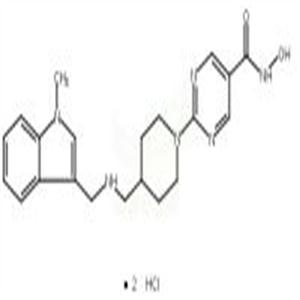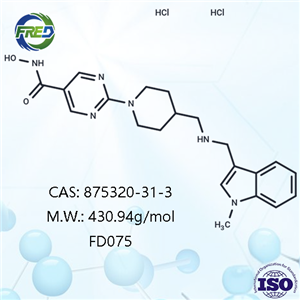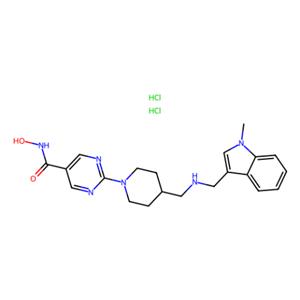| 名称 | Quisinostat dihydrochloride |
| 描述 | Quisinostat dihydrochloride (JNJ26854165(Quisinostat) 2HCl) is a novel second-generation HDAC inhibitor with highest potency for HDAC1 with IC50 of 0.11 nM in a cell-free assay, modest potent to HDACs 2, 4, 10, and 11; greater than 30-fold selectivity against HDACs 3, 5, 8, and 9 and lowest potency to HDACs 6 and 7. Phase 2. |
| 细胞实验 | All cell lines are obtained from American Type Culture Collection and cultured according to instructions. The effect of HDAC inhibitors on cell proliferation is measured using an MTT. Proliferation of non–small cell lung carcinoma (NSCLC) cell lines is assessed using an Alamar Blue–based assay. For proliferation of hematologic cell lines, cells are incubated for 72 hours and the cytotoxic activity is evaluated by MTS assay. Data are presented as mean IC50 or IC40 ± SD of at least three independent experiments.(Only for Reference) |
| 激酶实验 | HDAC activity assays : In all cases, full-length HDAC proteins are expressed using baculovirus-infected Sf9 cells. In addition, HDAC3 is coexpressed as a complex with human NCOR2. For assessing activity of HDAC1-containing cellular complexes, immunoprecipitated HDAC1 complexes are incubated with an [3H]acetyl- labeled fragment of histone H4 peptide [biotin-(6-aminohexanoic)Gly-Ala-(acetyl[3H])Lys-Arg-His-Arg-Lys-Val-NH2] in a total volume of 50μL enzyme assay buffer (25 mM HEPES (pH 7.4), 1 M sucrose, 0.1 mg/mL BSA and 0.01% (v/v) Triton X-100). Incubation is performed for 45 minutes at 37 °C (immunoprecipitates) or 30 min at room temperature. Before addition of substrate, HDAC inhibitors are added at increasing concentrations and preincubated for 10 minutes at room temperature. After incubation, the reaction is quenched with 35μL stop buffer (1 M HCl and 0.4 M acetic acid). Released [3H]acetic acid is extracted with 800μL ethyl acetate and quantified by scintillation counting. Equal amounts of HDAC1 are immunoprecipitated as indicated by Western blot analysis. HDAC1 activity results are presented as mean ± SD of three independent experiments on a single lysate. |
| 体外活性 | Quisinostat 在包括所有肺、乳腺、结肠、前列腺、大脑和卵巢肿瘤细胞系在内的实体和血液恶性肿瘤细胞系中展现出广谱抗增殖活性,其IC50值介于3.1-246 nM之间,与vorinostat、R306465、panobinostat、CRA-24781或mocetinostat相比,在测试的各种人类癌症细胞系中表现出更强的功效。[1] 最近的研究显示,Quisinostat通过导致Mcl-1耗竭和Hsp72诱导在低纳摩尔浓度下促进骨髓瘤细胞死亡。[2] |
| 体内活性 | 在HDAC1敏感型A2780卵巨细胞肿瘤筛选模型中,Quisinostat以其最大耐受剂量(10 mg/kg i.p. 和 40 mg/kg p.o.)连续3天给药,引发HDAC1调控的荧光反应,这预示了肿瘤生长抑制。此外,与5-氟尿嘧啶/亚叶酸钙相比,Quisinostat在抑制C170HM2结直肠肝转移癌的生长上显示出更强的抑制效果。[1] |
| 存储条件 | Powder: -20°C for 3 years | In solvent: -80°C for 1 year | Shipping with blue ice/Shipping at ambient temperature. |
| 溶解度 | DMSO : 73 mg/mL (156.19 mM), Sonication is recommended.
10% DMSO+40% PEG300+5% Tween 80+45% Saline : 2 mg/mL (4.28 mM), Sonication is recommended.
Ethanol : < 1 mg/mL (insoluble or slightly soluble)
H2O : < 1 mg/mL (insoluble or slightly soluble)
|
| 关键字 | Quisinostat Dihydrochloride | Quisinostat dihydrochloride | Quisinostat (JNJ-26481585) | Quisinostat | malignancies | JNJ26854165(Quisinostat) | JNJ-26481585 | JNJ26481585 | JNJ 26481585 | Inhibitor | inhibit | Histone deacetylases | histone | hematologic | HDAC4 | HDAC2 | HDAC11 | HDAC10 | HDAC1 | HDAC | deacetylase | Autophagy | Apoptosis |
| 相关产品 | Naringin | Guanidine hydrochloride | L-Glutamic acid | Gefitinib | Cysteamine hydrochloride | Alginic acid | Dextran sulfate sodium salt (MW 5000) | Hydroxychloroquine | Stavudine | L-Ascorbic acid sodium salt | Paeonol | Sodium 4-phenylbutyrate |
| 相关库 | 抗癌活性化合物库 | 经典已知活性库 | 抗癌化合物库 | 已知活性化合物库 | 自噬库 | 组蛋白修饰化合物库 | 抗衰老化合物库 | NO PAINS 化合物库 | 抗肺癌化合物库 | 药物功能重定位化合物库 | 抗癌临床化合物库 | 抗癌药物库 |




